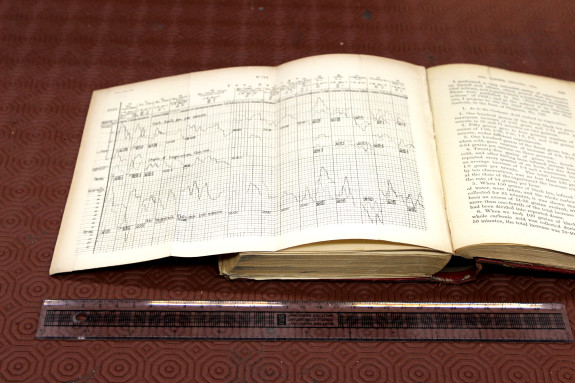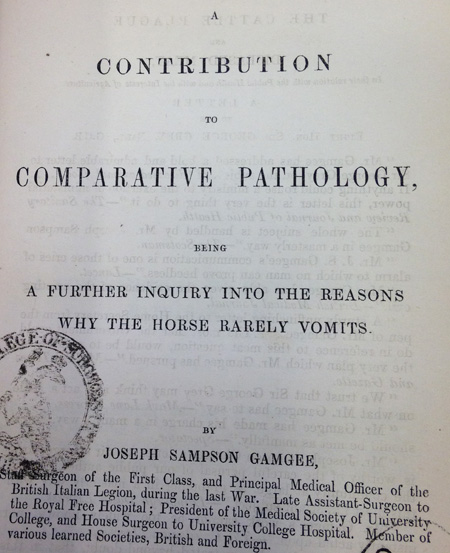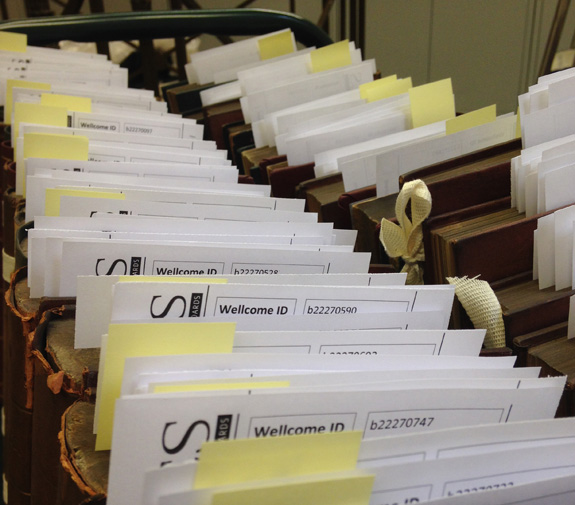As always, for more from the Medical Heritage Library, please visit our full collection!
Primary Source Sets
MHL Collections
Reference Shelves
As always, for more from the Medical Heritage Library, please visit our full collection!
As always, for more from the Medical Heritage Library, please visit our full collection!
 The Foundling Hospital, founded in 1739 by Captain Thomas Coram in London, is the subject of John Brownlow’s 1858 The history and design of the Foundling Hospital : with a memoir of the founder. At the time of the book’s publication, the Hospital was still on its original site in in Bloomsbury. The Hospital has since transitioned into a charitable foundation, named after the founder of the Hospital: Coram.
The Foundling Hospital, founded in 1739 by Captain Thomas Coram in London, is the subject of John Brownlow’s 1858 The history and design of the Foundling Hospital : with a memoir of the founder. At the time of the book’s publication, the Hospital was still on its original site in in Bloomsbury. The Hospital has since transitioned into a charitable foundation, named after the founder of the Hospital: Coram.
The Hospital itself has a fascinating history, starting from the very beginning with Coram’s lengthy struggle to get a Royal patent for the hospital and Parliamentary guarantees of funding to allow more children to be taken in. Approximately ninety-two children were taken in per year in the first fifteen years of the Hospital’s operations, the only restrictions in acceptance being a transmissible disease such as smallpox or syphilis. (9)
Brownlow’s is not the only history of the hospital and the London Metropolitan Archives and the Foundling Museum curate the Hospital’s records. Brownlow records that, as time went on and it became possible either that parents would want to reclaim their children or children track down their parents, those surrendering a child were requested to leave an identifying token: “A half-crown, of the reign of Queen Anne, with a hair. An old silk purse. A silver fourpence, and an ivory fish. A stone cross, set in silver.” (18) Many of these items, being quite durable, have survived and are held by one or the other of the above institutions.
Flip through the pages of Brownlow’s book below or follow this link to read The history and design of the Foundling Hospital : with a memoir of the founder.
We are grateful for the opportunity to cross-post content from the Wellcome Library’s blog about the UK MHL project! This post originally featured there on 5/13/2015.
The library of Royal College of Physicians (RCP) is delighted to be one of the ten UK partner organisations taking part in the UK-Medical Heritage Library (UK-MHL) project. Over next year, working with the Wellcome Library and the Internet Archive, the RCP will be sending books to be digitised and made available online for free.
The Royal College of Physicians was founded in 1518, which makes it the oldest royal medical college in England. The library was founded in the same year and grew mainly through donations and bequests. The Great Fire of London in 1666 destroyed much of the original collection, but the library survived and continued to grow through bequests and donations, as well as new purchases. Initially the collection was not limited to medical subjects, but from the 19th century it became focused on items relating to the work of physicians. The library is thriving today, offering access to contemporary resources for doctors and medical researchers and also historical items for those interested in the history of science and medicine. The RCP has many interesting and unique items which fall into the time period that the UK-MHL covers, 1780 to 1914.

I am project coordinator for the RCP and my role is very much a hands-on one. I am charged with hunting down all the books and pamphlets which are to be sent to the Internet Archive’s scan centre. Once I have located these items and gathered them altogether, I assess their suitability for digitisation. First, I check to see how tightly an item is bound. If it is too tight and the text is curling into the gutter, then unfortunately the platform on which the digitation process takes place will not be able to capture this text. This also applies to items which are larger than the platforms, so I make sure to have a ruler with me at all times checking the width of books and their gutters.
Next, I check to make sure there are no duplicate copies. If there are some duplicates, I must make a choice as to which copy will be sent for digitation. The decision can come down to condition or how tightly the item is bound. When all these things are equal I search for other distinguishing marks such as interesting annotations or a provenance which may interest readers. For example this copy of On a haematazoon inhabiting human blood : its relation to chyluria and other diseases is signed “with the author’s compliments”.
Once all the items have been checked and assessed as being suitable for digitisation, I set about packing the volumes. We use big, sturdy crates which hold about 50 items at a time. As these items are rare books I have to ensure that they are packed very carefully and securely. Layers of plastic sheeting, foam, and bubble-wrap are used to line the crate, with extra bubble-wrap used around the volumes, filling any gaps which may result to books sliding and being damaged. I must say this was the task that I was most nervous about carrying out but now, three batches later, I feel like I have mastered the UK-MHL packing technique.
One of the perks of being so hands on with the materials is that I get to take a look at all the wonderful information contained in the books and pamphlets. The RCP has a diverse collection; subject areas cover the breadth of medical and scientific enquiry, as well as topics such as heraldry, library science, linguistics, and religious texts. I am always on the look-out for interesting pictures, trivia, dedications and commentaries, and there is no shortage of these!
I particularly enjoyed looking at the books on therapeutic baths and spa trips. We have a number of these which covered healing spring resorts all over the world, and many even had helpful maps tucked away in pockets stuck to front covers. One book which stood out for me was Dress : its sanitary aspect. A paper read before the Brighton Social Union , January 30th, 1880. The book contains pictures of healthy bodies and what can happen to bodies after some styles of fashionable clothing are worn for long periods of time.
The aim of the project is to make historical resources available for researchers so that the understanding of the intersections of medicine, science and health can be enhanced. I must say that I am expanding my own knowledge on a daily basis through working with books such as The hygiene of the mouth: a guide to the prevention and control of dental diseases which detailed the types of dental treatment which were common for children in the 19th century and why.
As the project progresses we will be sharing some of the interesting items that we uncover through Twitter and the Library and Museum Blog. The books themselves will be available in their digitised formats through the Wellcome Library catalogue, the Internet Archive and, soon, JISC Historical Books. Make sure to check back regularly as books are continuously being updated. The original books will also be available for viewing in the RCP Library reading room.
Author: Alana Farrell is Project Coordinator UK-MHL, Royal College of Physicians London.
This month, our Monday images come from Matthew Robinson’s The new family herbal : comprising a description and the medical virtues of British and foreign plants, founded on the works of eminent modern English and American writers on the medical properties of herbs to which is added, the botanic family physician valuable medical receipts and important directions regarding diet , clothing, bathing, air, exercise, &c., &c. (1872)
As always, for more from the Medical Heritage Library, please visit our full collection!
As always, for more from the Medical Heritage Library, please visit our full collection!
The Medical Heritage Library is pleased to announce the addition of titles from the Migel Library of the American Printing House for the Blind.
The M.C. Migel Library at the American Printing House for the Blind is one of the largest known collections of materials related to visual impairment in the United States. The library holds over 20,000 items that range in scope from original research to fiction with characters or authors who are visually impaired. While a majority of the collection is historical, we continue to acquire large numbers of new and relevant items in various formats. The collection includes journals, agency reports, proceedings, organizational newsletters, and a large amount of non-English language materials. The Library is also unique in that it contains thousands of individually cataloged periodical articles that are not thought to be organized by the subject of visual impairment anywhere else. The Migel Library’s online catalog includes items from the Barr Research Library at APH. The Barr Library began in the 1970s as a collection of materials used or authored by the Research Department at APH. As a result, many of its 4,500 items are unique manuscripts that were researched and created at APH.
The Migel Library was started as a circulating collection at the American Foundation for the Blind (AFB) in New York in the 1920s. A reference library for the field was a major priority of AFB’s first director, Robert Irwin. In 1926, the AFB board granted him $1,000 to start the collection. Book donations flooded in from around the country at such a rate that Irwin needed to hire a full time librarian, Helga Lende, in 1929. Lende’s knowledge of the German, French, Spanish, and Scandinavian languages was essential to developing such an inclusive collection – especially considering the amount of blindness research coming out of Europe following the First World War. Lende’s 1940 bibliography Books About the Blind gives a sense of not only the popular literature being collected, but also many unpublished masters’ and doctoral theses in the Migel holdings. By the time Helga Lende retired in 1964, the library had become one of the largest collections in the world in its area of specialty. The Library was named after philanthropist Moses Charles Migel in 1963. Having been inspired by his experiences with blinded soldiers while serving with the Red Cross in World War I, Migel helped found AFB in 1921, and headed their board until 1945. The general stacks of the Migel Library were formally transferred from AFB to the American Printing House for the Blind in Louisville, KY, in 2009.
Digitization of materials began in 2010 as a limited, grant-based project consisting of our most significant items. Thanks to further funding through APH, we have been able to pursue a continuous digitization program for the foreseeable future. We are reviewing the stacks item-by-item to digitize every eligible volume. This includes the small pamphlets and articles that, while unique, were passed-over during the first phase of the project in the interest of efficiency. Our Internet Archive page now includes 2,270 items and we are steadily adding to the number. All future items will be automatically tagged as part of the MHL and thus made available through the MHL’s Internet Archive page, as well forming part of the corpus for the MHL’s full-text search tool and Bookworm.
About the MHL: The Medical Heritage Library (MHL) is a digital curation collaborative among some of the world’s leading medical libraries, promoting free and open access to quality historical resources in medicine. Our goal is to provide the means by which readers and scholars across a multitude of disciplines can examine the interrelated nature of medicine and society, both to inform contemporary medicine and strengthen understanding of the world in which we live. The MHL’s growing collection of digitized medical rare books, pamphlets, journals, and films number in the tens of thousands, with representative works from each of the past six centuries, all of which are available here through the Internet Archive.
From William P.C. Barton’s A flora of North America: illustrated by coloured figures, drawn from nature (Volume 2) (1821).
As always, for more from the Medical Heritage Library, please visit our full collection!
We are grateful for the opportunity to cross-post content from the Wellcome Library’s blog about the UK MHL project! This post originally featured there on 5/4/2015.
Over the next year the Library at the Royal College of Surgeons of England will be preparing almost 2,500 volumes to send to the Wellcome Library for digitisation as part of the UK Medical Heritage Library project. Carried out by a team-in-residence from Internet Archive at its Euston Road centre, this project will make our collections visible and accessible to a new, global audience.

Handling the items as I prepare them for digitisation is fascinating and I am frequently surprised at the variety of titles that I come across. While some may seem puzzling to today’s reader (for instance Joseph Sampson Gamgee’s 1852 inquiry “into the reasons why the horse rarely vomits”, with a further inquiry apparently necessary in 1857), others contend with issues still hotly debated even today, for example the effectiveness or necessity of vaccines, the form medical education should take, or who has responsibility for caring for the poor. Taking time to systematically examine the items is also proving useful for another on-going project at RCS England – a review which assesses the care, use, condition and significance of our entire collections (find updates and images of our [re]discoveries on twitter @HunterianLondon#CollectionsReview ).
Unusually, RCS England’s contribution will come entirely from its tracts and pamphlet collection, and consists of almost 22,000 individual titles bound in 2,500 volumes. This represents almost 80% of the pamphlet collection in total. Each item must be individually flagged with its unique identifier, a process that has caused the Library Collections Manager to scale new heights of expertise using Microsoft mail merge. The pamphlets are as diverse as they are numerous and their inclusion in the UK Medical Heritage Library indicates their rarity and interest.

Funding from the Wellcome Trust made it possible to catalogue RCS England’s tracts and pamphlet collection over four years, and the online visibility of these records has already resulted in higher usage of the collection. The UK Medical Heritage Library represents the next stage in enabling as many people as possible to use it. Items from our collection are already starting to appear on the Internet Archive site, and we are looking forward to even more people discovering some of its delights and using them in new ways.
Author: Dot Fouracre is Collections Review Assistant at the Royal College of Surgeons of England and also works part-time at the Wellcome Library.
Check out some of the latest additions to our collection!
As always, for more from the Medical Heritage Library, please visit our full collection!